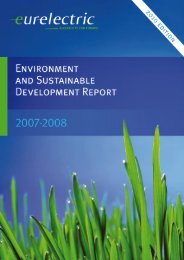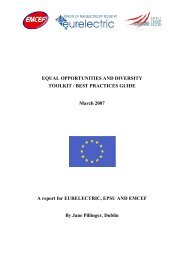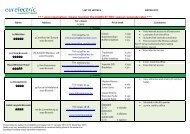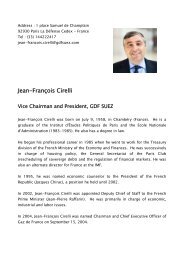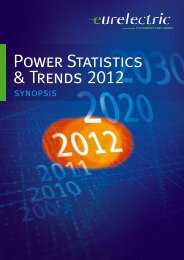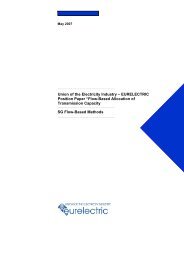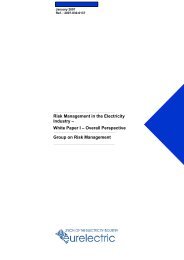Activity Report 2012 - Eurelectric
Activity Report 2012 - Eurelectric
Activity Report 2012 - Eurelectric
You also want an ePaper? Increase the reach of your titles
YUMPU automatically turns print PDFs into web optimized ePapers that Google loves.
More specifically, EURELECTRIC believes that a key<br />
underlying cause of current concerns about the ETS is<br />
the lack of coherence between the instruments being<br />
used to deliver the 20:20:20 policy objectives, and<br />
that the ETS must be defended as the most effective<br />
and market-compatible mechanism available to deliver<br />
greenhouse gas reductions. The Board therefore<br />
decided in november 2011 that EURELECTRIC needed<br />
to join the growing public debate on the ETS, or risk not<br />
being heard. In March <strong>2012</strong> the Board further decided<br />
to support a short-term fix to the ETS, linked to a longterm<br />
resolution of the coherence problem.<br />
During <strong>2012</strong> members of the Environment and<br />
Sustainable Development Policy Committee and its<br />
working groups, together with the Secretariat, have<br />
worked first to convince the EU institutions these issues<br />
need answering, and second to advocate our preferred<br />
answers. It is a slow and laborious task – our criticisms of<br />
the current EU 20:20:20 package have not always been<br />
welcome! nonetheless, as we move into 2013, there is<br />
potential for progress on both the 2030 CO 2 reduction<br />
target and the ETS during the remainder of the current<br />
EU mandate until november 2014.<br />
Policy coherence<br />
Concerning policy coherence, the crucial lesson learned<br />
by our sector about the 20:20:20 package is that its<br />
policy instruments are competing with one another.<br />
Strong subsidies for renewables and separate energy<br />
efficiency targets are undermining the electricity market<br />
and the effectiveness of the ETS as a market compatible<br />
tool for cost-effective emissions reductions.<br />
Throughout the year EURELECTRIC has repeatedly raised<br />
this concern with the Commission, most publicly at<br />
a EURELECTRIC workshop in October. Our key task<br />
in the first half of 2013 will therefore be to define<br />
EURELECTRIC’s preferred solution. One long-term answer<br />
being considered by the Commission is to focus on<br />
policies to deliver renewables and energy efficiency.<br />
But in this case the ETS would not be the driver for<br />
low-carbon investments. Another solution could be for<br />
the ETS to be the single policy instrument after 2020,<br />
with no additional support for mature renewables and<br />
energy efficiency technologies outside the carbon price.<br />
These are two scenarios for EURELECTRIC members to<br />
discuss. A middle-way solution is also being explored by<br />
EURELECTRIC using the Power Choices Re-Loaded study<br />
which will be published early in 2013.<br />
39



